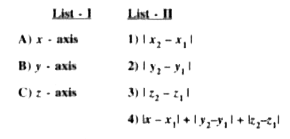Assertion (A): A(x1,y1,z1),B(x2,y2,z2). The projection of AB on the line with D.C's (l,m,n) is l(x2−x1)+m(y2−y1)+n(z2−z1)
Reason (R ) : The projection of the join of A (x1,y1,z1),B(x2,y2,z2) on yz plane is √(y2−y1)2+(z2−z1)2Solution in Telugu
Both A and R are ture and R is the correct explanation of A
Both A and R are true but R is not the correct explanation of A
A is true but R is flase
A is flase but R is true
The correct Answer is:B
Step by step video, text & image solution for Assertion (A): A(x_(1),y_(1),z_(1)), B(x_(2),y_(2),z_(2)). The projection of AB on the line with D.C's (l,m,n) is l(x_(2)-x_(1)) +m(y_(2)-y_(1))+n(z_(2)-z_(1)) Reason (R ) : The projection of the join of A (x_(1),y_(1),z_(1)), B(x_(2),y_(2),z_(2)) on yz plane is sqrt((y_(2)-y_(1))^(2)+(z_(2)-z_(1))^(2)) by Maths experts to help you in doubts & scoring excellent marks in Class 11 exams.
Updated on:21/07/2023Topper's Solved these Questions
- DIRECTION COSINES & RATIOSBOOK - AAKASH SERIESCHAPTER - DIRECTION COSINES & RATIOSEXERCISE - EXERCISE - II
18 Videos
- DIFFRENTATIONBOOK - AAKASH SERIESCHAPTER - DIFFRENTATIONEXERCISE - ADDITIONAL PRACTICE EXERCISE (PRACTICE SHEET (ADVANCED)) (Integer Type Questions)
5 Videos
- DIRECTION COSINES AND RATIOSBOOK - AAKASH SERIESCHAPTER - DIRECTION COSINES AND RATIOSEXERCISE - ADVANCED SUBJECTIVE TYPE QUESTIONS
8 Videos
Similar Questions
A line passes through the points (6,-7,-1) and (2,-3,1). The d.c's of the line so directed that the angle made by it with the positive direction of x-axis is acute are
View SolutionFor the function f(x)=∣∣x2−5x+6∣∣ , the right hand derivation f'(2+) is equal to
View SolutionIf the line joining the points (2,k,5), (0,1,6) is parallel to the line joining the points (3,-1,2), (-1,2,4) then find k,
View SolutionA=[[2,0,00,2,00,0,2]] and B=[[x_(1),y_(1),z_(1)x_(2),y_(2),z_(2)x_(3),y_(3),z_(3)]]
View Solutionयदि A=⎡⎢⎣200020002⎤⎥⎦ तथा B=⎡⎢⎣x1y1z1x2y2z2x3y3z3⎤⎥⎦ तो सिद्ध कीजिए कि AB=2B.
View Solutionबिन्दुओं (x1,y1,z1) और (x2,y2,z2) को मिलाने वाली रेखा के दिक्अनुपात हैं
View SolutionIf x1=3y1+2y2−y3, y1=z1−z2+z3
x2=−y1+4y2+5y3,y2=z2+3z3
x3=y1−y2+3y3, y3=2z1+z2
espress x1,x2,x3 in terms of z1,z2,z3.
View SolutionIf (x1,y1,z1),(x2,y2,z2),(x3,y3,z3) and (x4,y4,z4) be the consecutive vertices of a parallelogram, show that x1+x3=x2+x4,y1+y3=y2+y4 and z1+z3=z2+z4.
View Solutionयदि A=⎡⎢⎣200020002⎤⎥⎦ और B=⎡⎢⎣x1y1z1x2y2z2x3y3z3⎤⎥⎦ तो सिद्ध कीजिये कि AB=BA=2B
View SolutionFor x1,x2,y1,y2∈R if 0<x1<x2<y1=y2 and z1=x1+iy1,z2=x2+iy2 and z3=(z1+z2)/2,then z1,z2,z3 satisfy :
View SolutionXY - plane divides the line joining A(x1,y1,z1) and B(x2,y2,z2) in the ratio
View SolutionThe line segment joining A(x1,y1,z1),B(x2,y2,z2) is divided by XY- plane in the ratio
View SolutionZX-Plane divides the line joining A(x1,y1,z1),B(x2,y2,z2) in the ratio =
View SolutionLet x1andy1 be real number. If z1andz2 are complex numbers such that |z1|=|z2|=4, then |x1z1−y1z2|2+|y1z1+x1z2|2=
View SolutionA (x1,y1,z1),B(x2,y2,z2) are two points. Then the lenghts of projection on

View Solution
